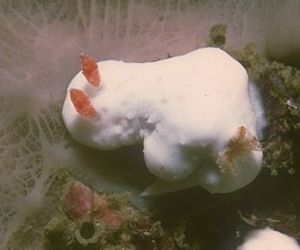
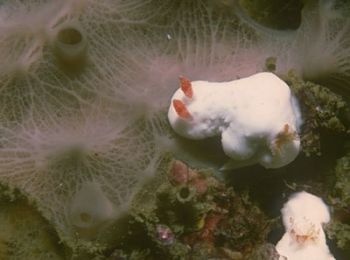
Noumea decussata
Risbec, 1928
Order: NUDIBRANCHIA
Suborder: DORIDINA
Family: Chromodorididae
DISTRIBUTION
Tropical West Pacific
PHOTO
on sponge, 70ft, Split Solitary Is, Coffs Harbour, nthn New South Wales, Australia. December 1989. PHOTOS: Carol Buchanan
Mantle white, sometimes with obscure yellow specks. Rhinophore clubs are red and the translucent clear gills have a red line along the inside edge. The mantle has pair of folds about two-thirds of the way down the body, given it a cross-like or cruciform appearance. There has been some confusion between this species and Noumea simplex in the literature, some of it no doubt due to Risbec (1953) misidentifying specimens of Noumea simplex as N. decussata. In Noumea simplex the mantle ranges in colour from pink to white and there is usually an orange-red line, often broken, along the edge of the mantle, and the tips of the gills and rhinophore clubs are bright orange. Compare also with Noumea romeri which also has a pinkish mantle. In that species there is a distinct whitish border to the mantle, the outer edge of the vibratile gills is orange and the upper half of the rhinophore clubs are orange.
See Scott Johnson's observations of N. decussata feeding on a yellow species of aplysillid sponge, and Carol Buchanan's photo here of it on another aplysillid. Both sponges seem different from the bright pink aplysillid sponge which N. simplex and N. romeri are usually associated with.
Authorship detailsRudman, W.B., 2001 (April 13) Noumea decussata Risbec, 1928. [In] Sea Slug Forum. Australian Museum, Sydney. Available from http://www.seaslugforum.net/find/noumdecu
Related messages
Data for Noumea decussata from Japan
September 25, 2003
From: Yukari Sato
Hello Dr.Rudman,
Thank you for posting my message about Noumea decussata on the Forum. It is a really pretty sea slug. I was also surprised that it only moved when light was shone on it. Here is some data for the photographed animal:
Date: 11 May,2003
Loc: Arari, Suruga bay west coast of Izu Peninsula, Japan
Size: approx.10mm.
Best wishes,
Yukari Sato
yuks@cg7.so-net.ne.jp
Sato, Y., 2003 (Sep 25) Data for Noumea decussata from Japan. [Message in] Sea Slug Forum. Australian Museum, Sydney. Available from http://www.seaslugforum.net/find/10989Thanks Yukari,
This background data is very valuable
Best wishes
Bill Rudman
Noumea decussata from Japan
September 15, 2003
From: Yukari Sato
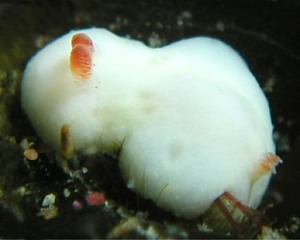
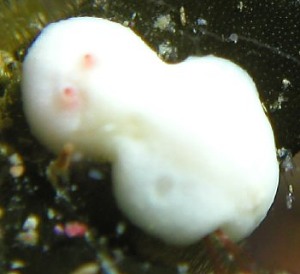
Hello Dr.Rudman,
I've found a unidentified sea slug. I've attached the image.
I felt it is Noumea simplex, but the rhinophore clubs are tipped in deep orange in N. simplex, but the whole color of the rhinophore is orange in my animal. I've found Noumea decussata on your Forum. The color of the rhinophore are the same. However the pattern of the gill is uncertain. it's not clear in my photo.
One thing I am wondering is that this sea slug can retract its rhinophores completely. It seems very sensitive. As far as I observe, N. simplex usually do not retract their rhinophore. Or I should say, they are not as sensitive. That may be why I do not see it?
Best wishes,
Yukari Sato
yuks@cg7.so-net.ne.jp
Sato, Y., 2003 (Sep 15) Noumea decussata from Japan. [Message in] Sea Slug Forum. Australian Museum, Sydney. Available from http://www.seaslugforum.net/find/10282Dear Yukari,
I'm pretty sure that this is N. decussata. I am not sure if it is more sensitive than N. simplex .
Can you let me know where you photographed your animals so I can add it to the data please?
Thanks
Bill Rudman
Noumea decussata clustering
August 22, 2001
From: Scott Johnson
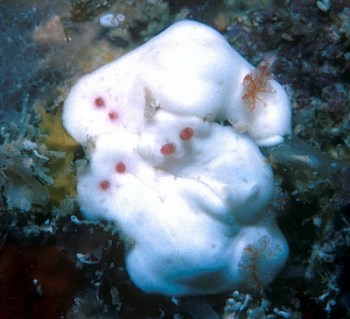
Hi Bill,
I've noticed the clustering behavior you pointed out in T. Kenji's photo of N. subnivalis in a couple of other small white Noumea as well. Here is a somewhat fuzzy photo of three N. decussata clustered on a small chunk of their yellow sponge prey. It was taken at Enewetak Atoll, Marshall Islands. Pictures of clustering behaviour in N. simplex are in a separate message.
Scott
johnson@kmr.ll.mit.edu
Johnson, S., 2001 (Aug 22) Noumea decussata clustering. [Message in] Sea Slug Forum. Australian Museum, Sydney. Available from http://www.seaslugforum.net/find/5119Thanks Scott,
After mentioning 'clustering' I couldn't find a photo to refer to so your contributions are very welcome. While posting this message I also discovered that in your earlier message on Noumea decussata the animals in your photos all illustrate the other point I made about Noumea - how many species, when resting, fold their mantle on either side into a prominent fold.
Best wishes,
Bill Rudman
Noumea decussata from the Marshall Ids
April 16, 2001
From: Scott Johnson
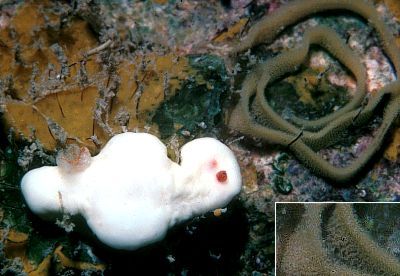
Hi Bill,
Attached are three Noumea decussata for the Forum. The species was relatively common along one shallow subtidal reef at Enewetak Atoll, Marshall Islands, where it shared the habitat with the similar looking N. simplex. I'm embarrassed to say that for some time I did not properly distinguish between the two species. Once I finally did, it became apparent that while N. simplex fed on a pink sponge, N. decussata preferred a species of yellow encrusting sponge. I believe the egg mass in the upper right photo was deposited by that animal.
Scott.
johnson@kmr.ll.mit.edu
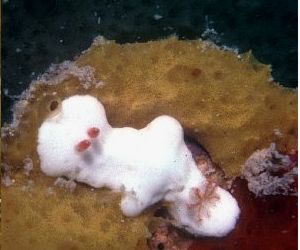
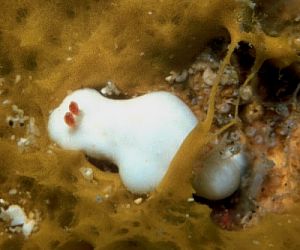
Thanks Scott,
With help from you all I am gradually getting most of the species of Noumea on the Forum. Still a few to go, but we are getting there.
I am glad you found a distinction in the food sponge of N. simplex and N. decussata. Although quite a few species apparently share the same food sponges, it does help when we can make such a distinction. Examples like yours help illustrate the value of keeping an eye out for biological information when hunting and photographing nudibranchs.
Best wishes,
Bill Rudman
